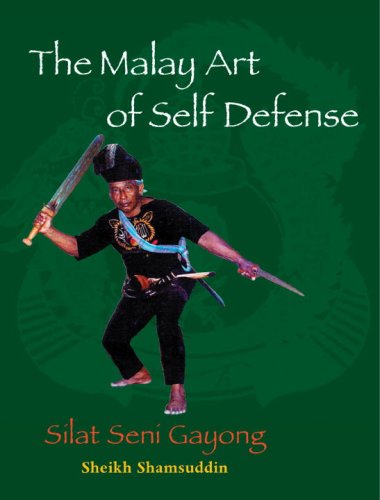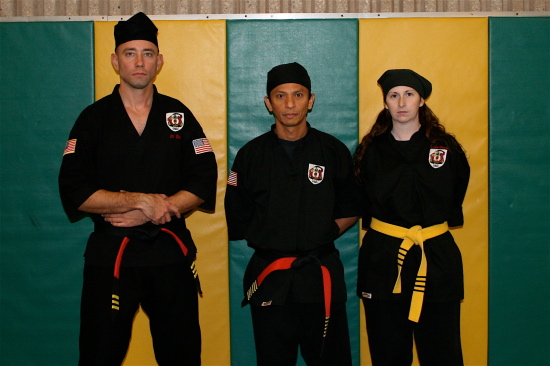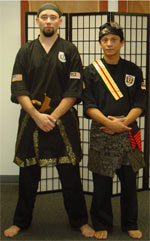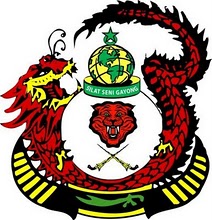The
Malay Art of Self-Defence
Silat Seni Gayong
Review by Mohd Nadzrin Wahab

Remember
what Buzz Aldrin said when he stepped on the moon? No one does, because
Armstrong went first [1].
In the same way, the West has rarely accorded its fair share of silat credit,
often citing it as an Indonesian martial art, with anything of a Malaysian
nature accorded the status of 'variants'.
It is true that although there exist styles such as Cimande, Cikalong, Lintau, Terlak and many others within the borders of Malaysia, but many nationalists are hesitant to call them Malaysian, because of their obvious Indonesian roots.

However,
not all silat arts were imported wholesale from Indonesia. There do exist
fundamentally and popularly accepted Malaysian Silat that have been flourishing
for the past 50 years and more. One of these is the ever present, ever regal,
Silat Seni Gayong.
Once
looked upon curiously by Indonesian-styled martial artists in the West, Silat
Seni Gayong soon became known for its brutal locks and throws, something many
Malaysians were already acquainted with.
Several
masters who visited or relocated to Western countries eventually became the
vanguards of Silat Seni Gayong in that region. Names such as guru Sulaiman
Shariff (USA), guru Yeop Ariffin Yeop Mahidin (UK) and guru Sheikh Shamsuddin S.
M. Salim (USA) are known for their tireless efforts in promoting Silat Seni
Gayong across borders.
Now,
guru Shamsuddin has taken it one step further, by writing the first
comprehensive book on Silat Seni Gayong for public consumption, to be published
anywhere in the world.
Published
by North Atlantic Books and available online at Barnes & Noble, the book
titled THE MALAY ART OF SELF-DEFENCE: SILAT SENI GAYONG (GAYONG) contains a
straightforward primer on silat and its history from a Malaysian perspective and
that of Silat Seni Gayong itself.
Sourced from interviews and articles readily available in Bahasa Melayu and tied together with his own knowledge and experience in the art, guru Shamsuddin has created a powerful introduction to Malaysian Silat by way of Silat Seni Gayong.
GAYONG
gives a brief explanation to clear away confusions regarding the many different
organisations that purport to teach Silat Seni Gayong. He makes it clear to the
reader, that there is no enmity between the organisations and all of them accept
one unifying fact, that the late Datuk Meor Abdul Rahman Meor Hashim is the
Mahaguru of Silat Seni Gayong.
 Readers
are taken through the various customs and rituals of Silat Seni Gayong,
including the famed hot oil bath. Unfortunately, the author barely skims the
issue of kebatinan (spirituality) in
Silat Seni Gayong, pro-bably due to the level of credibility such topics attain
in the West.
Readers
are taken through the various customs and rituals of Silat Seni Gayong,
including the famed hot oil bath. Unfortunately, the author barely skims the
issue of kebatinan (spirituality) in
Silat Seni Gayong, pro-bably due to the level of credibility such topics attain
in the West.
However,
Malaysians reading GAYONG would be sorely disappointed by his decision because
it remains one of Silat Seni Gayong's hallmarks.
Probably
the most valuable addition to the book is a section of questions and answers
where the author has collected 34 of the most valid and inane questions ever to
be asked by a foreigner (most of them his own students) about Silat and Melayu
culture, which he answers satisfactorily.
A
section of historical and current Silat Seni Gayong photographs illustrate just
how far this Malaysian Silat style has come since it was first taught publicly
at Pulau Sudong in 1942.
Guru
Shamsuddin is obviously familiar with the difficulties non-natives who study
silat have with the Melayu language and the terms used in the course of teaching
the art. He includes a glossary of the terms and a basic conversational helper
which ensures that anyone can at least ask if he's attractive to someone else
(Is it hot?-Panas?).
All
in all, GAYONG is an invaluable resource to have for anyone keen on finding out
just what is Malaysian Silat?
I
recommend it to those who are currently, intend to or are just curious about
studying Silat Melayu. Future books on Malaysian Silat will discover that this
one is truly a tough act to follow.

Guru Shamsuddin can be contacted at shamsudd@cdnet.cod.edu
or through the official United States Gayong Federation website http://malaysilat.org.
[1] Unabashed dialogue lifting from the ‘First Flight’ (2nd season) episode of STAR TREK: ENTERPRISE.
![]()
If you'd like to learn a little more about our Guest Editor and Silat expert Mohd Nadzrin Wahab, check out his CV here. You can also reach him via email.